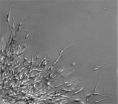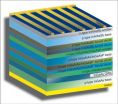(Press-News.org) Monthly temperature extremes have become much more frequent, as measurements from around the world indicate. On average, there are now five times as many record-breaking hot months worldwide than could be expected without long-term global warming, shows a study now published in Climatic Change. In parts of Europe, Africa and southern Asia the number of monthly records has increased even by a factor of ten. 80 percent of observed monthly records would not have occurred without human influence on climate, concludes the authors-team of the Potsdam Institute for Climate Impact Research (PIK) and the Complutense University of Madrid.
"The last decade brought unprecedented heat waves; for instance in the US in 2012, in Russia in 2010, in Australia in 2009, and in Europe in 2003," lead-author Dim Coumou says. "Heat extremes are causing many deaths, major forest fires, and harvest losses – societies and ecosystems are not adapted to ever new record-breaking temperatures." The new study relies on 131 years of monthly temperature data for more than 12.000 grid points around the world, provided by NASA. Comprehensive analysis reveals the increase in records.
The researchers developed a robust statistical model that explains the surge in the number of records to be a consequence of the long-term global warming trend. That surge has been particularly steep over the last 40 years, due to a steep global-warming trend over this period. Superimposed on this long-term rise, the data show the effect of natural variability, with especially high numbers of heat records during years with El Niño events. This natural variability, however, does not explain the overall development of record events, found the researchers.
If global warming continues, the study projects that the number of new monthly records will be 12 times as high in 30 years as it would be without climate change. "Now this doesn't mean there will be 12 times more hot summers in Europe than today – it actually is worse," Coumou points out. For the new records set in the 2040s will not just be hot by today's standards. "To count as new records, they actually have to beat heat records set in the 2020s and 2030s, which will already be hotter than anything we have experienced to date," explains Coumou. "And this is just the global average – in some continental regions, the increase in new records will be even greater."
"Statistics alone cannot tell us what the cause of any single heat wave is, but they show a large and systematic increase in the number of heat records due to global warming," says Stefan Rahmstorf, a co-author of the study and co-chair of PIK's research domain Earth System Analysis. "Today this increase is already so large that by far most monthly heat records are due to climate change. The science is clear that only a small fraction would have occurred naturally."
###Article: Coumou, D., Robinson, A., Rahmstorf, S. (2013): Global increase in record-breaking monthly-mean temperatures . Climatic Change (online) [doi:10.1007/s10584-012-0668-1]
Weblink to the article: http://link.springer.com/article/10.1007/s10584-012-0668-1
For further information please contact:
PIK press office
Phone: +49 331 288 25 07
E-Mail: press@pik-potsdam.de
Global warming has increased monthly heat records by a factor of 5
2013-01-14
ELSE PRESS RELEASES FROM THIS DATE:
Protein identified that can disrupt embryonic brain development and neuron migration
2013-01-14
Interneurons – nerve cells that function as 'dimmers' – play an important role in the brain. Their formation and migration to the cerebral cortex during the embryonic stage of development is crucial to normal brain functioning. Abnormal interneuron development and migration can eventually lead to a range of disorders and diseases, from epilepsy to Alzheimer's. New research by Dr. Eve Seuntjens and Dr. Veronique van den Berghe of the Department of Development and Regeneration (Danny Huylebroeck laboratory, Faculty of Medicine) at KU Leuven (University of Leuven) has identified ...
Research makes connetion between tubal ligation and increase in cervical cancer rates
2013-01-14
Women who have a tubal ligation – the surgical tying or severing of fallopian tubes to prohibit pregnancy – have less frequent Pap smears, which puts them at an increased risk for cervical cancer, according to research recently released by a team that included Cara A. Mathews, MD, a gynecologic oncologist at the Program in Women's Oncology at Women & Infants Hospital of Rhode Island.
The findings were part of the National Cancer Institute-funded study "Study to Understand Cervical Cancer Endpoints and Determinants" being conducted when Dr. Mathews was a fellow at the ...
Liver controls wasting in cancer
2013-01-14
Cachexia or wasting is a condition affecting up to 70 percent of cancer patients, depending on the type of cancer. It is characterized by a dramatic loss of body weight that is independent of food intake. Cachexia is seen particularly often and most pronounced in patients suffering from cancers of the digestive tract and the lungs. They may lose up to 80 percent of body fat and skeletal muscle. Muscle loss leads to weakness and immobility of patients and poorer response to treatment. An estimated 20 percent of cancer deaths are considered to be a direct consequence of cachexia, ...
Dynamic, dark energy in an accelerating universe
2013-01-14
This press release is available in Spanish.
It was cosmology that drew Irene Sendra from Valencia to the Basque Country. Cosmology alsogave her the chance to collaborate with one of the winners of the 2011 Nobel Prize for Physics on one of the darkest areas of the universe. And dark matter and dark energy, well-known precisely because so little is known about them, are in fact the object of the study bySendra, a researcher in the Department of Theoretical Physics and History of Science of the UPV/EHU's Faculty of Science and Technology.
"Observations tell us that ...
NRL designs multi-junction solar cell to break efficiency barrier
2013-01-14
WASHINGTON -- U.S. Naval Research Laboratory scientists in the Electronics Technology and Science Division, in collaboration with the Imperial College London and MicroLink Devices, Inc., Niles, Ill., have proposed a novel triple-junction solar cell with the potential to break the 50 percent conversion efficiency barrier, which is the current goal in multi-junction photovoltaic development.
"This research has produced a novel, realistically achievable, lattice-matched, multi-junction solar cell design with the potential to break the 50 percent power conversion efficiency ...
Using lysine estimates to detect heat damage in DDGS
2013-01-14
URBANA – Distillers dried grains with solubles (DDGS) are a good source of energy and protein in swine diets. However, they can be damaged by excessive heat during processing, compromising their nutritional value. University of Illinois researchers have found that it is possible to assess heat damage by predicting the digestibility of lysine in DDGS.
Excessive heat causes some of the lysine in DDGS to bond with sugars and form Amadori compounds. The lysine bound in these compounds is called unreactive lysine; pigs cannot digest it. Lysine that is not bound is referred ...
Amino acid studies may aid battle against citrus greening disease
2013-01-14
This press release is available in Spanish.Amino acids in orange juice might reveal secrets to the successful attack strategy of the plant pathogen that causes citrus greening disease, also known as Huanglongbing or HLB. Studies of these amino acids by U.S. Department of Agriculture (USDA) chemist Andrew P. Breksa III and University of California-Davis professor Carolyn M. Slupsky may pave the way to a safe, effective, environmentally friendly approach to undermine Candidatus Liberibacter asiaticus, the microbial culprit behind HLB.
The scientists used nuclear magnetic ...
ASH international clinical collaboration replicates high cure rate of APL in developing countries
2013-01-14
(WASHINGTON) – Data published online today in Blood, the Journal of the American Society of Hematology (ASH) describe the work of an ASH international clinical network collaborative focused on modernizing treatment protocols for patients in the developing world with acute promyeloctyic leukemia (APL) that has drastically improved cure rates in patients in Central and South America, achieving comparable outcomes to those observed in patients in the United States and in Europe.
APL is a rare, aggressive cancer of the blood and bone marrow that can be fatal in a matter ...
Better care from doctors who are culturally aware
2013-01-14
HIV patients from ethnic minorities receive better quality of care from doctors and other primary healthcare professionals who are the most competent at caring for patients from diverse backgrounds – those who are "culturally competent." These patients also tend to manage both their treatment and condition better, according to a new study¹ by Somnath Saha from Portland VA Medical Center, and the Oregon Health & Science University in the US, and colleagues. Their findings appear in the Journal of General Internal Medicine², published by Springer.
The authors explored whether ...
The secret sex life of the penicillin-producing fungus could make it more productive
2013-01-14
New and more effective strains of the fungus used to produce penicillin could be developed after a team of international scientists unearthed the secret sex life of Sir Alexander Fleming's fungus Penicillium chrysogenum (P. chrysogenum).
The scientists from The University of Nottingham, Ruhr-University Bochum, The University of Göttingen, and Sandoz GmbH have announced a major breakthrough in our understanding of the sex life of the fungus P. chrysogenum. Their research looks sets to lead to the introduction of new and more effective strains of the world's first antibiotic ...


